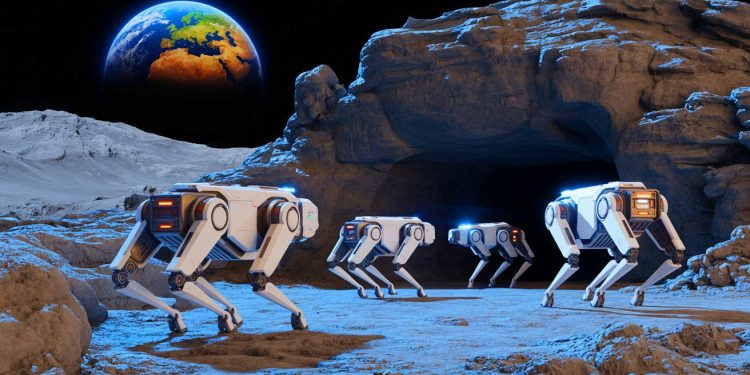| IN A WORD |
|
In a groundbreaking initiative, a team of researchers from Peking University is leading efforts to unlock the Moon’s hidden secrets using innovative robotic technology. These robotic dogs, designed specifically for lunar exploration, represent a significant advancement in space technology. They are intended to navigate and analyze lunar lava tubes, underground tunnels formed by ancient volcanic activity. These structures could potentially house future lunar bases, providing protection against harsh conditions such as radiation and micrometeorites. Testing has already begun in a geologically similar cave near Lake Jingbo in China’s Heilongjiang province. This development not only signifies progress in space exploration but also in the field of robotics and artificial intelligence, promising new methods of exploring uncharted territories.
Pioneers of robotics for lunar exploration
The concept of using robotic dogs for lunar missions is a strategic response to the challenges posed by the lunar environment. These robots are designed to serve as scouts in areas that are inaccessible or too dangerous for human explorers. According to Zhang Shanghang, a researcher involved in the project, these robotic explorers are equipped with autonomous navigation capabilities. This means they can move and make decisions independently, without the need for direct human control.
One of the striking characteristics of these lunar robots is their ability to avoid obstacles. They are equipped with advanced sensors that allow them to detect and avoid potential dangers in their path. This feature is crucial for navigating the rugged and unpredictable terrain of the Moon’s lava tubes. In addition, the robots are capable of 3D mapping, thanks to sophisticated on-board technology. This allows them to create detailed digital models of their environment, providing valuable data to researchers.
‘Engineers warn this could change everything’: Spider-like robot prints full house in 24 hours, aims to build shelters on the Moon
In addition, these robots integrate embodied intelligence, combining physical movement and artificial intelligence. This allows them to adapt in real time to the complex and changing lunar landscape, enhancing their effectiveness as exploration tools.
Importance of Lunar Lava Tubes
Lunar lava tubes are of particular interest to scientists and space agencies because of their potential to support future human activities on the Moon. These natural formations are considered ideal locations for establishing lunar bases. They provide natural protection against harsh conditions on the Moon’s surface, including extreme temperatures, micro-meteorite impacts and harmful radiation. By exploring these structures, researchers hope to find viable sites for long-term human habitation.
‘AI just solved the impossible’: Scientists shocked as GPT-5 exposes hidden limits of quantum computing’s error reduction
The robotic dogs’ mission is to navigate these tubes, assessing their size, condition and suitability for future use. The information collected by the robots will be instrumental in planning future lunar missions and eventually establishing a lasting human presence on the Moon. The use of robotic technology in this context highlights a shift towards more autonomous and technologically advanced methods of space exploration.
Testing and development in geosimilar environments
Testing these robotic dogs in a lava tube-like cave near Lake Jingbo is a crucial step in their development. This site was chosen because its geological characteristics closely resemble those expected on the Moon. By operating in this environment, researchers can evaluate the robots’ capabilities and make necessary adjustments to improve their performance.
This penny-sized robot reveals a shocking in-flight trick that terrifies scientists and changes everything in robotics
According to a statement from a researcher affiliated with the Beijing Artificial Intelligence Research Institute, testing in such a realistic setting was invaluable. This allows the team to refine the robotic technology, ensuring it is well suited to the demands of lunar exploration. This real-world testing phase is essential to identify potential challenges and iterate on solutions before deployment in space.
The knowledge gained from these trials will not only benefit lunar exploration, but will also have broader implications for the development of autonomous robotic systems. These advances could pave the way for future missions to other celestial bodies, such as Mars, where similar exploratory challenges exist.
The Future of Lunar Exploration and Beyond
The deployment of robotic dogs on the Moon is a promising development in the broader context of space exploration. As the international space community aims for a return to the Moon and beyond, technologies like these will play a crucial role. They provide a safer and more efficient means of exploration, reducing the risks associated with manned space travel.
Additionally, the success of this initiative could spur further innovation in robotics and AI technologies. It highlights the potential for collaboration between different research areas, leading to advancements that benefit not only space exploration but other industries as well. As these technologies evolve, they could open up new possibilities for exploring and understanding our universe.
Looking ahead, the question remains: How will the integration of advanced robotics and artificial intelligence continue to transform our approach to exploring the unknown reaches of space?
This article is based on verified sources and supported by editorial technologies.
Did you enjoy it? 4.4/5 (20)









